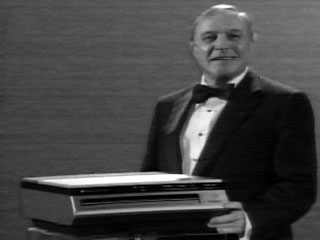
 |
Search | FAQ | US Titles | UK Titles | Memories | VaporWare | Digest | |||||||
| GuestBook | Classified | Chat | Products | Featured | Technical | Museum | ||||||||
| Downloads | Production | Fanfares | Music | Misc | Related | Contact | ||||||||
| Memories of VideoDisc - Who's Who in VideoDisc | ||||||||||||||

Gene Kelly was a celebrity spokesperson for the CED system from 1983 to 1984. Here he appears with the SGT250 in the dealer demonstration CED title "Gene Kelly and RCA VideoDisc" explaining his long relationship with RCA and his enthusiasm for the SelectaVision VideoDisc system.
Along with Fred Astaire, Gene Kelly was the most successful song-and-dance man in film history, a towering figure in the development and enduring success of the movie musical. Born August 23, 1912, in Pittsburgh, PA, he initially studied economics, funding his education by working alternately as a soda jerk and a brick layer. With brother Fred, he also gave dancing lessons. In 1937, the Kelly brothers both unsuccessfully sought choreography work in New York. A year later, however, Gene was cast in the chorus of Leave It to Me, and in 1939 he graduated to a small role in the revue One for the Money. A more prominent performance in the drama The Time of Your Life caught the attention of Richard Rodgers, who cast him as the titular Pal Joey. Kelly left Broadway for Hollywood when David O. Selznick offered him a contract, immediately loaning him to MGM to star opposite Judy Garland in 1942's For Me and My Gal. At the insistence of producer Arthur Freed, MGM bought out the remainder of Kelly's Selznick contract, and cast him in the 1943 war drama Pilot No. 5.
After the musical Du Barry Was a Lady, Kelly appeared in the all-star Thousands Cheer. The Cross of Lorraine, a Resistance drama, quickly followed. MGM then loaned him to Paramount for the Rita Hayworth vehicle Cover Girl and also allowed him to share choreography duties with an up-and-coming Stanley Donen, who continued on as his assistant. The result was a major critical and commercial hit, and while the follow-up, Christmas Holiday, passed by unnoticed, 1945's Anchors Aweigh -- which cast Kelly opposite Frank Sinatra -- earned him a Best Actor Oscar nomination, confirming his brilliance as a dancer and choreographer as well as solidifying his increasing power at the box office. In 1944, Kelly had starred in Ziegfield Follies, but the picture did not see the light of day until two years later. In the interim he served in the Navy, and upon returning from duty starred in 1947's Living in a Big Way. For 1948's The Pirate, Kelly teamed with director Vincente Minnelli, followed by a turn as D'Artagnan in The Three Musketeers. Next, in the 1948 Rodgers-and-Hart biography Words and Music, he teamed with Vera Ellen for a performance of "Slaughter on Tenth Avenue."
In 1949, Kelly and Donen contributed the original story for Take Me Out to the Ball Game. Later that year, the duo was handed the directorial reins for the classic On the Town, a groundbreaking, exuberant adaptation of the Betty Comden/Adolph Green/Leonard Bernstein Broadway smash. Black Hand (a Mafia drama) and Summer Stock (another collaboration with Garland) followed before Kelly reteamed with Minnelli for 1951's masterful An American in Paris, one of the most acclaimed musicals in Hollywood history. In addition to seven Academy Awards, including Best Picture, it also earned Kelly a special Oscar in honor of "his versatility as actor, singer, director, and dancer, and specifically for his brilliant achievements in the art of choreography on film." After the stop-gap It's a Big Country, Kelly and Donen mounted 1952's Singin' in the Rain, arguably the most honored and beloved musical in the canon; a tale of Hollywood set as the silent era gave way to the sound era, it represented an unparalleled zenith for the musical comedy genre, and Kelly's centerpiece performance of the title song remains among the most indelible sequences in film.
From this peak, however, there was seemingly nowhere else to go but down; Kelly traveled to Europe to qualify for tax exemption, and there shot a lifeless German thriller, The Devil Makes Three. In Britain, he began work on a planned all-ballet project, Invitation to the Dance, but the picture was never completed. Finally shown in its unfinished state in 1956, it received disastrous critical notice. In the U.K., Kelly also starred in Seagulls Over Sorrento before returning stateside for Minnelli's disappointing Brigadoon. Again working with Donen, he co-directed 1955's It's Always Fair Weather. A slight return to form, it performed poorly at the box office, another sign of the impending demise of the Hollywood musical. Kelly also directed and starred in 1957's whimsical The Happy Road, but after headlining George Cukor's Les Girls, MGM told him they had no more musicals planned for production, and he was freed from his contract. A number of independent projects were announced, but none came to fruition. Instead, Kelly starred in 1958's Marjorie Morningstar for Warners and then directed the romantic comedy The Tunnel of Love.
In between appearing as a reporter in 1960's Inherit the Wind, Kelly returned to the stage. In 1958, he directed a Broadway production of the musical Flower Drum Song and two years later choreographed a Parisian ballet based on Gershwin's Concerto in F. He also appeared frequently on television, starring in the series Going My Way based on the movie of the same name. In 1964, Kelly returned to film, appearing with Shirley MacLaine in What a Way to Go! Two years later, he starred in Jacques Demy's musical homage Les Demoiselles de Rochefort. He also continued directing, most famously 1969's Hello Dolly!, but was largely inactive during the 1970s. In 1980, he starred opposite Olivia Newton-John in the much-maligned Xanadu, but the performance was his last for the big screen. Kelly later starred in a pair of TV miniseries, 1985's North and South and Sins, but then spent his remaining years in retirement, out of the spotlight. Gene Kelly died February 2, 1996, at the age of 83.
- All Movie Guide Biography
Gene Kelly in the Internet Movie Database.
If you have some additional information to supply on Gene Kelly, feel free to submit the form below, so your comments can be added to this page.
Send your comments in email via the Contact page